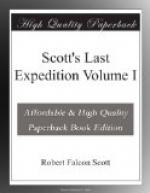Taylor gave us a paper on the Beardmore Glacier. He has taken pains to work up available information; on the ice side he showed the very gradual gradient as compared with the Ferrar. If crevasses are as plentiful as reported, the motion of glacier must be very considerable. There seem to be three badly crevassed parts where the glacier is constricted and the fall is heavier.
Geologically he explained the rocks found and the problems unsolved. The basement rocks, as to the north, appear to be reddish and grey granites and altered slate (possibly bearing fossils). The Cloudmaker appears to be diorite; Mt. Buckley sedimentary. The suggested formation is of several layers of coal with sandstone above and below; interesting to find if it is so and investigate coal. Wood fossil conifer appears to have come from this—better to get leaves—wrap fossils up for protection.
Mt. Dawson described as pinkish limestone, with a wedge of dark rock; this very doubtful! Limestone is of great interest owing to chance of finding Cambrian fossils (Archeocyathus).
He mentioned the interest of finding here, as in Dry Valley, volcanic cones of recent date (later than the recession of the ice). As points to be looked to in Geology and Physiography:
1. Hope Island shape.
2. Character of wall facets.
3. Type of tributary glacierscliff or curtain, broken.
4. Do tributaries enter ‘at grade’?
5. Lateral gullies pinnacled, &c., shape and size of slope.
6. Do tributaries cut out gullies—empty
unoccupied cirques,
hangers, &c.
7. Do upland moraines show tesselation?
8. Arrangement of strata, inclusion of.
9. Types of moraines, distance of blocks.
10. Weathering of glaciers. Types of surface.
(Thrust mark? Rippled,
snow stool, glass house, coral
reef, honeycomb, ploughshare,
bastions, piecrust.)
11. Amount of water silt bands, stratified, or
irregular folded
or broken.
12. Cross section, of valleys 35 deg. slopes?
13. Weather slopes debris covered, height to which.
14. Nunataks, height of rounded, height of any
angle in profile,
erratics.
15. Evidence of order in glacier delta.
Debenham in discussion mentioned usefulness of small chips of rock—many chips from several places are more valuable than few larger specimens.
We had an interesting little discussion.
I must enter a protest against the use made of the word ‘glaciated’ by Geologists and Physiographers.
To them a ‘glaciated land’ is one which appears to have been shaped by former ice action.
The meaning I attach to the phrase, and one which I believe is more commonly current, is that it describes a land at present wholly or partly covered with ice and snow.
I hold the latter is the obvious meaning and the former results from a piracy committed in very recent times.




